Subtleties of landscape design of a land plot
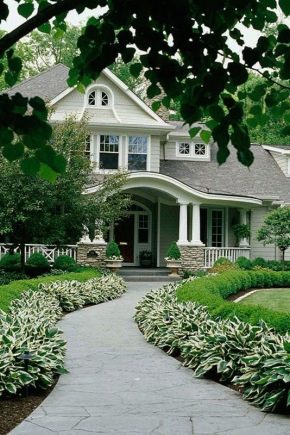
Even having built a good house on the site, finished it properly and provided with all the necessary communications, the arrangement of the territory cannot be considered complete. It is imperative to arrange the entire area adjacent to the dwelling, limited only by the boundaries of the land plot itself. And this should be done as clearly and competently as possible.
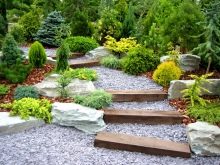
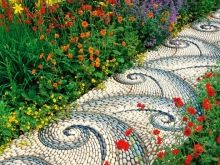
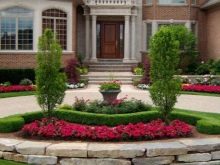
What it is?
Landscaping is a set of measures to comprehensively improve the properties of the adjoining space. In no case can it be reduced only to manipulating plants and decorative elements. First, a holistic concept is created, and only in accordance with it, the improvement of the land plot is carried out. This work is the lot of professionals; a layman is unlikely to be able to competently implement all the requirements, arrange the site naturally and uncomplicated.
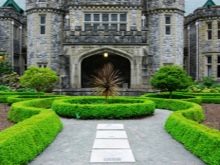
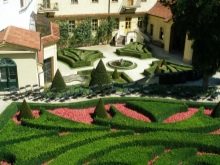
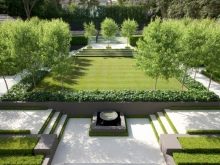
Landscaping involves not only manipulating color, shape and various plants; The master must know what geoplastics and geotextiles are, what other modern techniques, materials and structures can be used to improve the properties of the territory and how.
Of course, one cannot ignore the relief, the appearance of the buildings, the nature of the illumination.
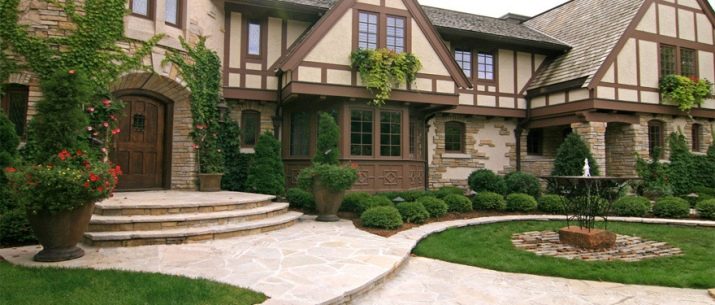
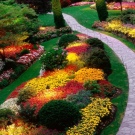
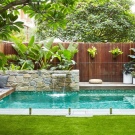
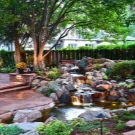
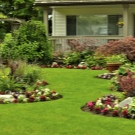
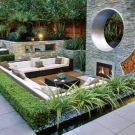
Styles
The style of the garden plot is closely related to the design of architectural structures, moreover, it directly follows them.
English landscape type implies a setting as natural as possible, a complete rejection of the correct geometric configurations. If reservoirs are created, then they are made simple in appearance, as if they appeared in a natural way. The paths are laid most often winding; strictly natural materials are used for their design. Vertical gardening prevails over horizontal.
Other characteristic features of the landscape style are luxurious flower arrangements and the obligatory use of ornamental shrubs.
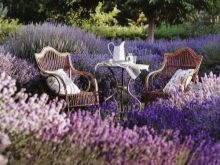
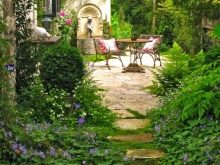

The so-called regular style... Its obligatory feature turns out to be strictly consistent geometry and symmetry of individual parts of the site, design elements. Flower beds and alleys, ponds and pergolas are actively used, gazebos are erected, areas are decorated with arches, sculptural compositions and columns. The French trend is best combined with the use of topiary plants.
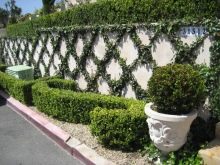

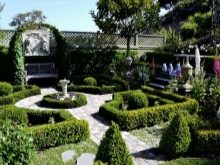
A modern and very attractive design option for a land plot that is not inferior to classical solutions is country... It is suitable for adherents of simplicity and naturalness; it is recommended that when choosing it, limit yourself to decorative materials of natural origin. Around a country house, country music requires planting plums, apple trees, mint, bird cherry and other plants that are typical for your climatic zone. Flower beds and benches, wicker fences are used as additional decor.
Similar in characteristics to country scandinavian design... Often the garden is equipped with a meadow and an oasis; fences and internal fences are not placed between parts of the territory, since the priority is given to the openness of the entire land.
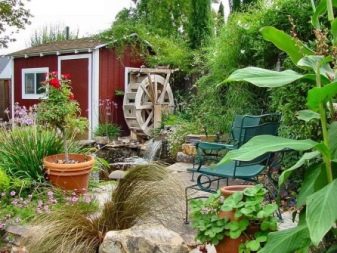
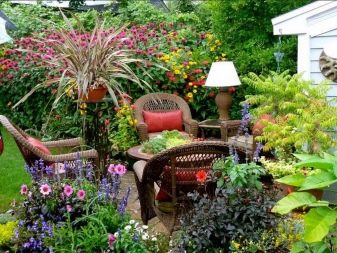
Modernist format it is distinguished by the active use of small architectural forms and accessories; plants are given a secondary role. The lines are predominantly arched, natural materials are still preferred.The range of colors is limited - blue, beige, red, black, silver, chocolate and purple are used.
For a very long time (at least 6 centuries), an element such as parterre has been used in various styles of landscape design. This is a separate front part of the land plots, the most solemn and expressive in comparison with the rest.
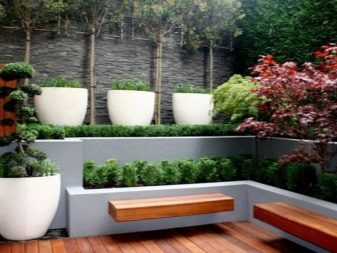
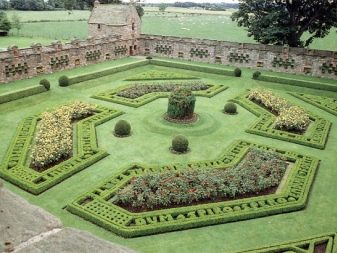
It is here that sculptures, fountains are traditionally erected, and artificial reservoirs are created. One of these decorative elements is placed in the center and acts as a semantic organizer of the surrounding space. They try to plant not too tall trees with a possibly denser crown around the perimeter.
It is definitely worth briefly telling about how garden terraces are decorated according to all the rules of decorating art. The type of terraces is determined by the characteristics of the garden: in rocky areas, you can use the most bizarre geometric shapes, so long as they fit into the surrounding space. On slopes, trench, stepped or ditch options are preferred. It is very important to immediately determine whether the terrace will be open or closed, this will predetermine the possibility of using it in the cold season of the year.
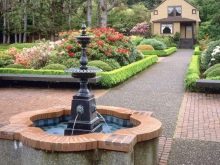
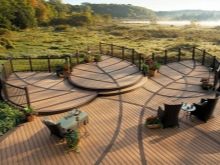

Territory planning
Regardless of which style you have chosen and into which parts you have decided to split your garden, you need to think over the layout of the land to the smallest detail. Otherwise, a situation will arise when there is not enough space for a certain element or two different parts are too close. It is imperative to take into account the relief, the total area, the passage of communications, the placement of buildings. Proximity to the road, sanitary restrictions, unstable ground in some areas or severe slope of a hill can all block or make it very difficult to carry out planned works.
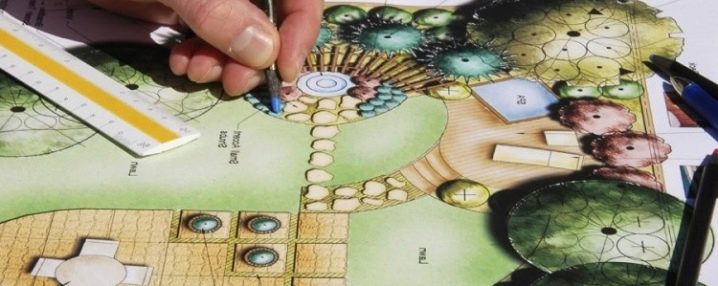
The basics of planning also touch upon such an important point as the height of the standing water table. They can benefit some plants and become a source of problems for others, especially in the lowlands. The choice of the type of plantings should be dictated not only by this consideration and external attractiveness, but also by the nutritional value of the soil and light and wind regimes.
Arrangement of a land plot does not begin with a scrupulous consideration of all the above circumstances and other parameters. In fact, with due diligence, almost any project can be implemented on any land.
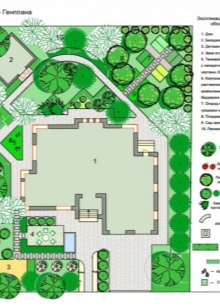
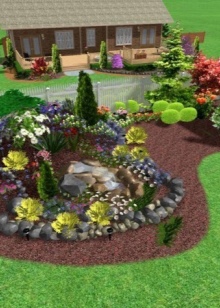
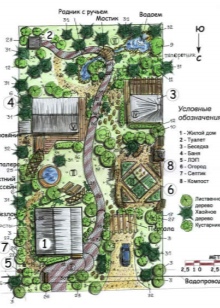
You only need to clearly define priorities - what is most valuable to you:
- Personal recreation area;
- Space for meeting friends;
- Family leisure corner;
- Romantic garden;
- Garden;
- Flower beds occupying the entire available territory;
- The presence of a large lawn.

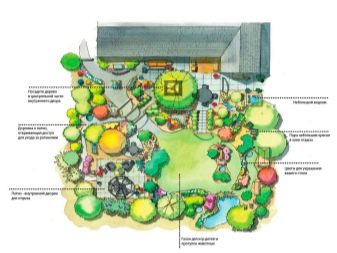
The way the entrance area is designed is determined, first of all, by the choice of the traditional Russian or modern European approach. In the first case, the emphasis is on achieving maximum privacy, closeness of personal space, and in the second, it is more public and is not even always limited to a fence. Since it makes no sense to allocate a significant area for this share of the site, its decoration should be as laconic and capacious as possible in order to express design ideas as clearly as possible in a limited area.
All ready-made solutions should not be taken as a guide to action, these are just some templates within which you should find your way to the ideal garden and local area.
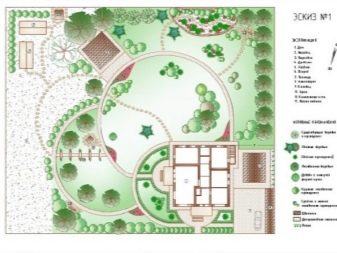

Zoning
Zoning is closely related to the layout of a land plot, giving individual parts a certain functional role. No matter how unusual, exclusive you would like to create a garden, a vegetable garden, take your time, prepare several drawings, diagrams with various options.
A well-thought-out composition takes into account not only all the necessary functionally territories, the routes of garden paths are necessarily worked out.Places where columns and other decorative elements will be placed should also be put on the plan and think about whether they will look beautiful in the designated place, whether they will create inconveniences.

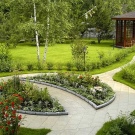
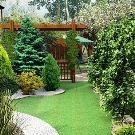



Landscaping
A land plot cannot be properly equipped without the use of green plants, otherwise it looks dull and expressionless. You need to carefully choose the culture with which you will decorate the space around the house and at the gate. Let's briefly consider a number of the most popular options.
Barberries have been loved by landscape designers for quite some time., although initially this plant was valued as a seasoning and medicinal raw material. Species diversity has led to a significant range of colors and shapes, the possibility of barberry entering into a very different composition.
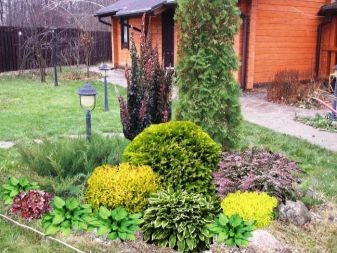
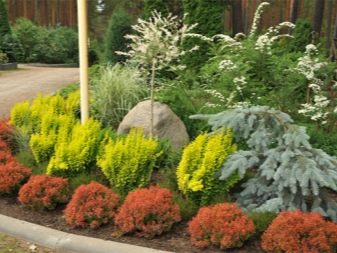
Russian gardeners add to the list of these advantages, allocated in all countries, necessarily resistance to negative factors: desiccation, strong winds, shading and excessive lighting.
The decorative properties of perennial barberries are preserved until the first cold weather. In the first and second years of development, the branches become thicker and denser, which allows you to create not just a beautiful composition, but also a hedge.
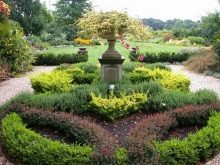
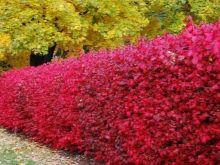
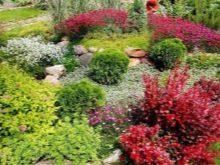
This plant can also be used as part of alpine slides and rockeries, rock gardens, framing the perimeter of lawns and flower beds. In landscape design, the use of barberry as a predominant and as an auxiliary species is equally well developed.
When choosing a site for it, focus primarily on well-lit, open and not prone to the accumulation of groundwater. Barberry grows best on loam, but in extreme cases it can also be bred in depleted soil.

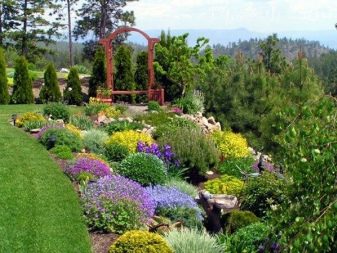
Rhododendrons confidently compete with barberries. Their other name is "rose tree", although in fact it is, rather, a tree-like shrub, a close botanical relative of heather. This family includes both deciduous and evergreen and transitional species between these types. Rhododendron prefers to grow where there is a lot of water, goes well with other plants; for landscape designers, it is attractive for the widest species diversity, which allows you to pick up a very beautiful bush in any garden.
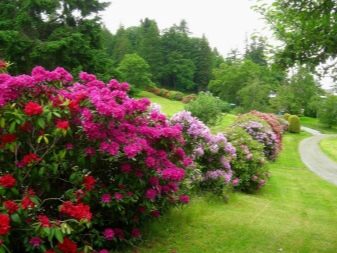
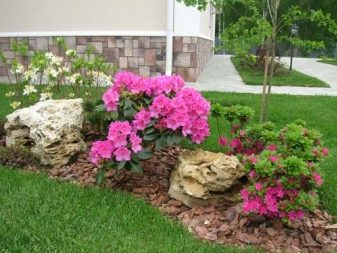
Any evergreen variety requires partial shade, deciduous - the sun, but excluding the ingress of drafts. 100% of rhododendrons thrive best in loose, well-drained and moist soil with an acidic chemical reaction. For those who want to decorate their site as long as possible, this plant will be a real find - skillful selection will ensure continuous flowering for up to 4 months in a row. Rosewood performs well next to bodies of water, on the edges of lawns and wherever the air humidity is above normal.
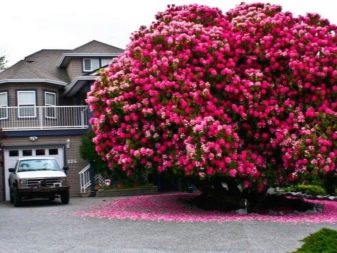
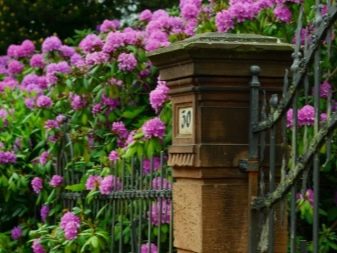
The use of a spirea will also be an elegant design solution. - a number of varieties are known under this name. Experts recommend planting them in a group of several bushes, and not distributing them in different places. To decorate the lawn or the road passing next to the site (entrance for transport), it is worth using the Douglas spirea. However, in areas with especially harsh winters, Billard's spirea is valued, reaching 2 m in height, giving spreading branches. The Japanese variety is also unpretentious and can grow even in the polar regions. Its flowers delight the owners of the earth during the whole summer.
Spireas should be planted in hedges, leaving a gap of 500 mm for bushes in a row and 300-400 mm for row spacing. In a group composition, the individual spacing is increased to 600 or even 700 mm to create a more attractive look. Planting time is the beginning of autumn, preferably on a rainy day, in order to make life less difficult for yourself by watering the seedlings.
Maintenance is limited to the introduction of nutrients on dry days and immediately after pruning, weed control and regular loosening of the soil.
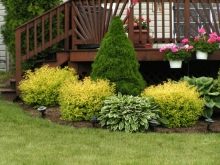
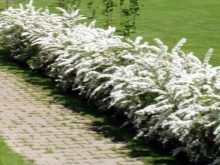
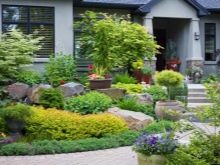
Hosts are no less beautiful than spirea; with a skillful approach, they alone can decorate an entire site. Deciduous culture harmoniously enters into a flower bed of any kind, into an alpine hill; Its value is the graceful foliage at the very roots, characterized by a wide range of tonalities and configurations. Only with the onset of frost does the time for bright, colorful hosts pass. But individual varieties are able to delight the gardener again and again with the onset of a new season for as long as 25 years. Although like other flowers, the hosta appreciates watering, but can do without it for a certain time (during dry periods or in the absence of owners).
Large leaves effectively suppress weeds by shading them, which reduces the need for weeding. Please note that newly appeared shoots can be destroyed by an invasion of snails and weevils. Hosta can be easily combined with any kind of plants, does not suffer from them itself and does not cause counter damage.
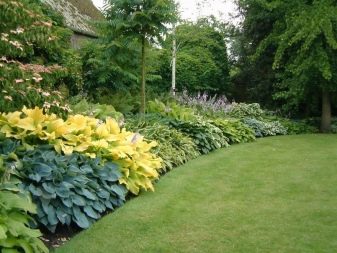
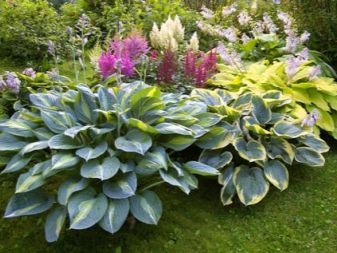
Ornamental cabbage - an attractive biennial flower, stretching up to 1.3 m, and its diameter is 100 cm. A typical design solution is to close the gaps in the area with ornamental cabbage. It is recommended to plant it where the appearance of the vegetable can be enjoyed without unnecessary problems. Remember, there are no edible parts in this plant! Ornamental cabbage wins a lot when combined with saffron, physalis, marigolds; in stand-alone form, it often plays the role of a decorative border.
The advantage of the "green head" is resistance to humidity, overheating and hypothermia; gardeners will like that there are no hard and fast rules for growing it, you yourself choose the appropriate pattern for planting. Experts recommend planting ready-made seedlings in open ground, and the soil for sowing seeds is carefully disinfected.

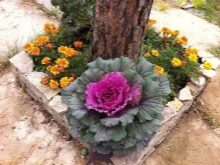
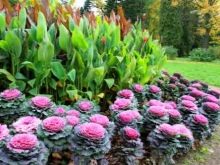
If you do not limit yourself to more or less known options, even among people far from gardening, you should pay attention to such a plant as pyracantha. This sun-loving perennial blooms every June, its growth ranges from 2 to 5 m. The thorny bushes, decorated with toothed leaves, produce, although non-poisonous, but unsuitable for food. In the temperate climate zone, the pyracantha narrow-leaved is most in demand, and if it is planted in the southern regions of the Russian Federation, the plant will easily survive in the open field.
The red variety is lower, but in the autumn months it is covered with very attractive leaves. Such a plant perfectly manifests itself on poor soils, easily survives powerful pruning.
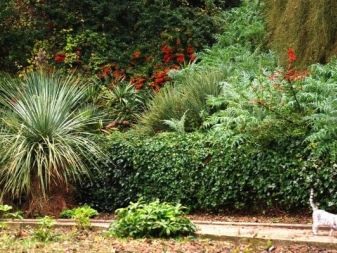

The fireplace, by the way, can also be integrated into the green area; a place for burning scraps, branches, other garden debris is sometimes made out in the form of a mobile bowl. Then it becomes not only a street hearth, but also a real decoration of the surrounding area. Important: choose a place that is at least 5 m from the nearest tree, bush, residential building and outbuilding. The official regulations are not so strict, but the concern for safety is never superfluous. It is advisable to pave the ground surrounding the fireclay with fireclay bricks or other stone blocks, or simply asphalt it.
Be sure to place a barrel of water or sand next to it, or better yet, supplement it with a fire extinguisher for maximum safety.
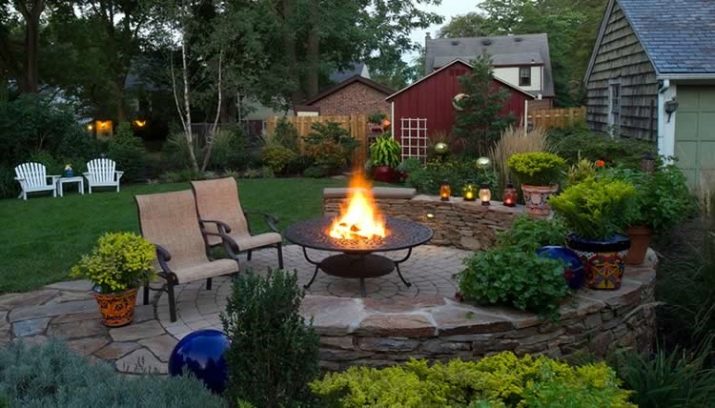
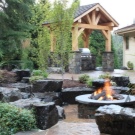


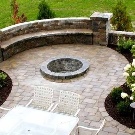
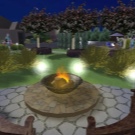
But back to the ornamental plants (we still have time to burn the dry herbs collected in the fall). Daylilies are next in line; These are perennial crops that are distinguished at the same time by their unpretentiousness and excellent appearance, elongated flowering. It is advisable to immediately decide whether you want to create a serious flower garden or are going to organize a solitary planting. When composing a composition, with daylilies you need to combine dahlias, catnip, crocosmia, loosestrife, agapanthus, any bulbous plants (but they will need to be highlighted in the flowerbed).
Bruner is also a perennial culture, however its main role is to compose mixborders and flower group. In warm weather in the autumn months, re-flowering is possible, the flowers are vaguely similar to forget-me-nots. When organizing the composition, try to clearly highlight the main background and transitions between flowers, between tall and squat plants.
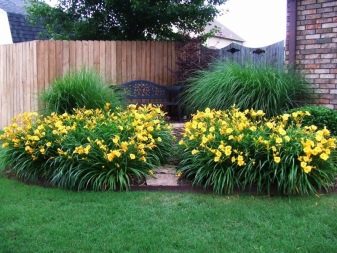

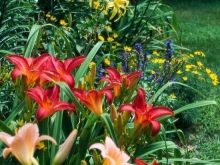
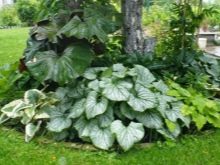

Continuing the review of ornamental plants that, for example, the Arteza company can offer, it is worth paying attention to astilbe. Their attractiveness is understandable, because a long-term beautiful option that does not require sophisticated care, capable of growing on a variety of soils, is liked by many. Bushes come in very different heights, differ from each other and color, and the appearance of the peduncles. Even when not blooming, astilbe seems to be very romantic and intriguing, complementing the ensemble of any garden. Within the framework of this culture, you can pick up varieties that give flower stalks from the first warm days until the end of August.
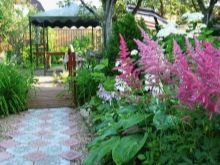
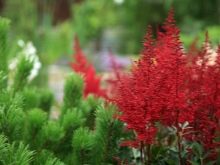
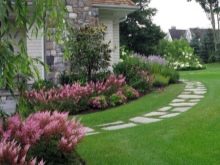
If you want to try to grow something less exotic, maximally adapted to Russian conditions, you should choose a haretail. This is not a flower, but a grass, but this is the special charm of a plant: even in a very small green corner it is easy to create the feeling of a "real" meadow.
Decorative cereal is suitable for rock garden and rockery; it will look appropriate on the bank of a specially dug stream bed.
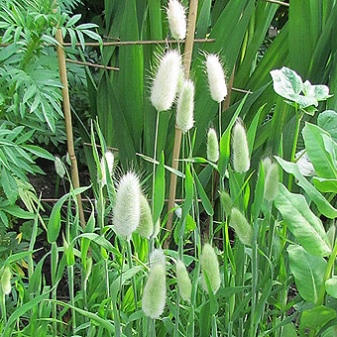
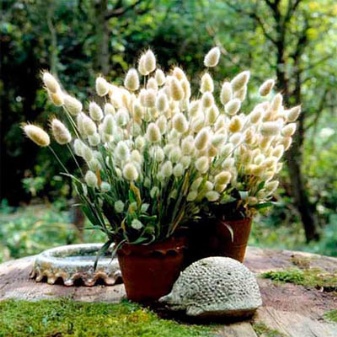
Since we are talking about artificial structures, it is imperative to mention mafs (small architectural forms). These are, for example, pretty flowerpots, right on the site in which graceful flowers and small shrubs can grow. But to enjoy the look of the garden, many other mafs have been invented. Bridges are thrown across the streams, gazebos are placed for relaxation, fountains and sculptures delight the eye, lanterns shining on the benches bring a romantic mood.
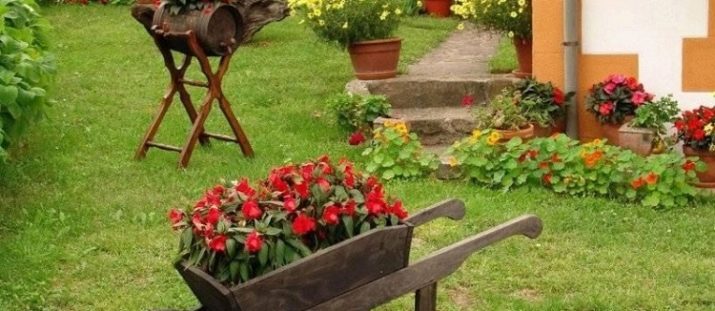
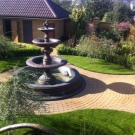
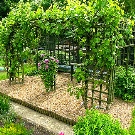
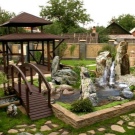

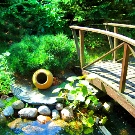
The Ginnal maple is represented by trees and shrubs reaching a height of 300 - 500 cm, the flowering duration is 21 days, the crown is asymmetric, the trunk is curved, and the bark is twisted vertically. Both a single landing and interaction with other species are possible. The combination of a black trunk with a neat green lawn is very attractive.
Gladioli are far inferior to maples in heightbut not attractive! They are capable of both framing other flowers and acting in the foreground. Keep in mind that even professional designers find it difficult to find the optimal combination for a gladiolus. Particular attention should be paid to their proportions in relation to other plants.
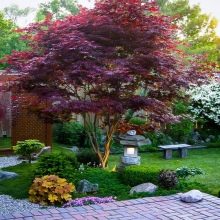
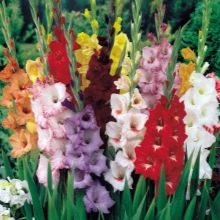

After the flower, the next shrub is kochia. An annual from the family of haze is extremely easy to carry a haircut, and every spring takes on a new color. From a distance, kohija is very easy to confuse with cypress. The plant will hold out without any problems during the dry season, without losing its qualities.
Heather began to be used as an ornamental plant in England, and now interest in it is growing again. So you may well be at the height of fashion if you choose this particular plant.

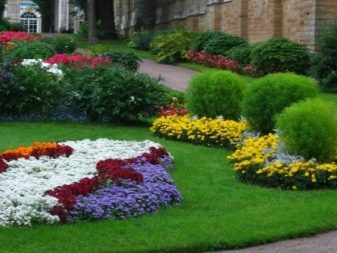
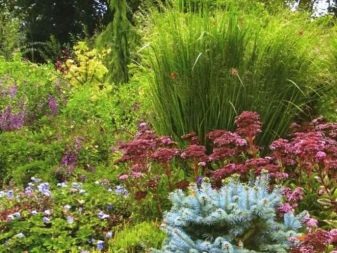
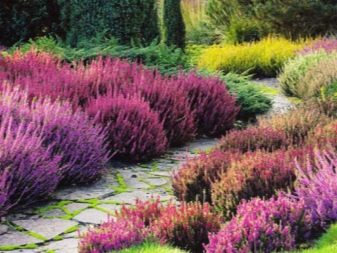
Fir has been in wide demand for a long time. Unlike heather, they did not experience a decline in popularity. It is difficult to find another coniferous plant in our latitudes that would be more beautiful. But the problem is that you will have to establish a very thorough care of the plantings, otherwise you will ruin them. Take care of weed control, and systematic watering, and the elimination of pests.
Boxwood is a tree much harder than fir, and is rightfully considered one of its main competitors. However, shrubs can also appear under this name, and the largest boxwoods can live 400 and even 500 years. Any such tree, bush brings a sense of volume to the landscape, adds texture. They are easy to cut and transform.
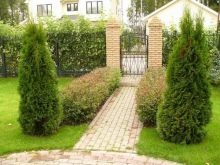
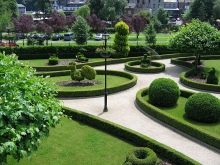
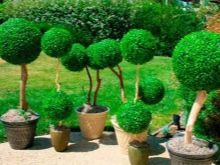
The hellebore is no less a legendary plant among gardeners than the boxwood. It is a cold-resistant flower that has both double and white-green colors at different stages of growth.Particularly enthusiastic assessments are always caused by a cup-shaped flower that blooms throughout the second half of spring. Resistance to dry times should be listed among the pluses of the hellebore, but keep in mind that all parts of the plant contain substances that are toxic to humans. It is not recommended to transplant flowers, they do not tolerate this process well and will hurt for a long time.
If there is a desire to plant not only a beautiful, but also gastronomically attractive plant, it is difficult to find an option better than an apple tree. However, decorative varieties of this tree do not always produce edible fruits, since selection cultivates their external beauty of flowering in the first place.
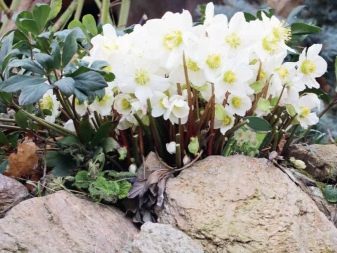
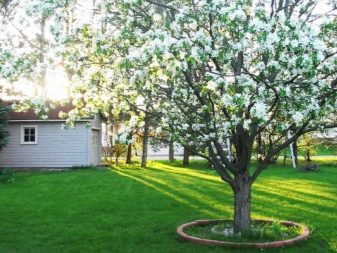
The size of the planting holes should be larger than the size of the root systems, each of the roots is carefully straightened and made sure that it is all covered with earth.
Lilac does not give tasty fruits at all, but in its grace it can compete with an apple tree. Her scent is absolutely incomparable. You can use such bushes for a large and single planting, in the form of a continuous composition and as a hedge. It is recommended to combine lilacs with tree peonies, mock orange, hydrangea and with our "old friends" - barberry, spirea.
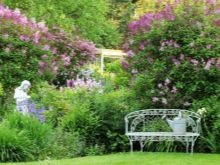
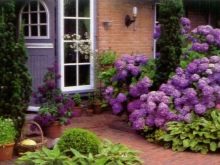

Decor elements
Decor ideas can be aimed at complementing the landscape (wooden objects, gazebo), revitalizing it (lamps, lanterns), at placing conceived accents. So, bridges are capable not only of connecting the shores, but also visually pulling them together. Any of the small architectural forms harmoniously combines practicality and aesthetic qualities. The main principle of landscape design is that all elements should be harmoniously combined with each other and with the environment, giving the site a sense of completeness.
Decorative islands try to fill not only the acquired forms, but also those that were made to order or performed individually. With a skilful approach, even seemingly hopeless materials and structures can become very attractive if the exposition is correctly assembled and natural and artificial lighting is well thought out.
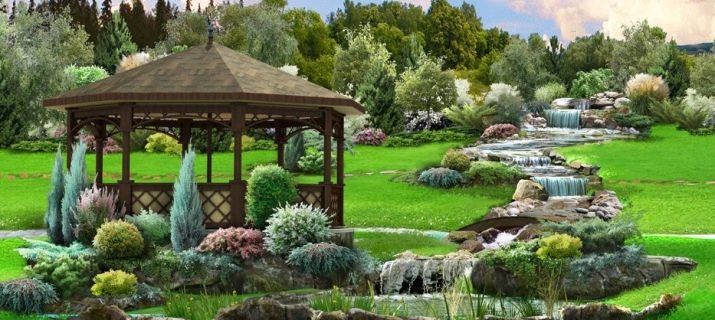
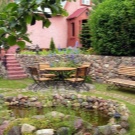


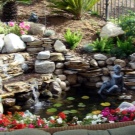
With the help of decor, you can delimit the space and externally subdivide the site into fragments; basically, they try to isolate the working and recreational shares, to emphasize their difference as much as possible. If there is a well in the garden, it can be surrounded by a bosquet (an unbreakable green wall in the form of a square bush), and retaining walls are sometimes formed on the slopes. But this is no longer just an element of decor, but a rather complex engineering structure.
Colored crushed stone is not an architectural form, but it can give a very attractive color to garden paths and embankments. Along with this, people are attracted by zero toxicity and the undeniable naturalness of this material.
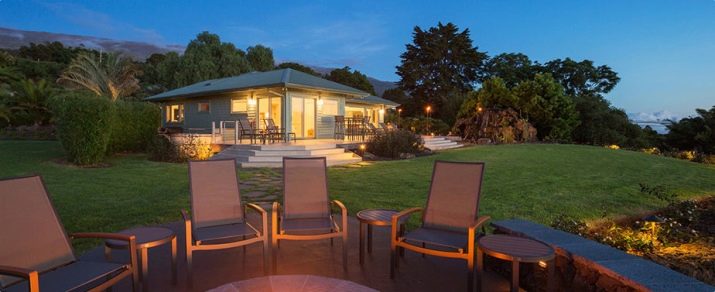
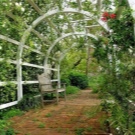
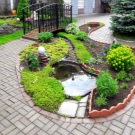
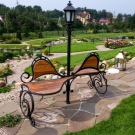

Beautiful examples
The elite landscaping of the courtyard invariably includes the use of both herbaceous plants and shrubs and trees. Attractive options are when plants of different heights are separated from each other in space, each has its own special area. A garden path can be harmoniously combined with beautiful flowers, visually breaking them into groups. It is advisable to achieve color and geometric symmetry between the parts of the planting.
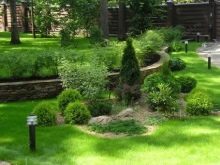
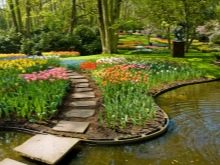

Retaining walls can play the role of a space divider not only horizontally, but also vertically. Experts recommend making the design of the top and bottom points similar in color, using a grassy lawn for each of them.
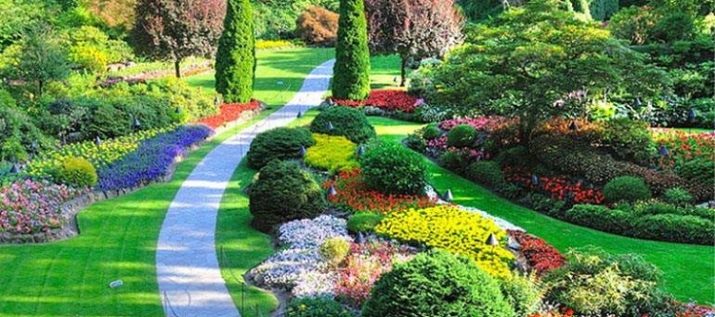
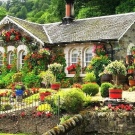


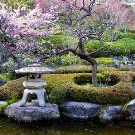
For information on how to properly plan a site, see the next video.



































































The comment was sent successfully.